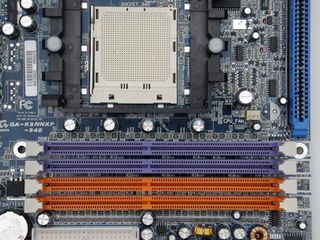Athlon64 Boards Found Lagging in Memory Support
Athlon64 And FX: Single Or Dual Channel

The Athlon64 FX needs the 940 pins, as two memory channels can be controlled with a total of 6.4 GB/s.
The most important difference between the Athlon64 and its big brother Athlon64 FX is the memory interface. While the Athlon64 can only control one channel, the Athlon64 FX offers support for two memory channels. The advantage here is the double memory range, which is still one of the key factors for a fast system.
An FX system equipped with just one DIMM module would only be quicker than the Athlon64 because it works 200 MHz quicker (Athlon64 FX-51 with 2.2 GHz and Athlon64 3200+ with 2.0 GHz), the 3400+ at 2.2 GHz performs equally. Nevertheless, it's unlikely that anyone will spend over $700 on an Athlon64 FX just so that they can save on internal memory.
The opposite case is however conceivable, namely to equip a computer on the basis of the Athlon64 with two memory modules. We want to examine what this can lead to below.

The Athlon64 manages with 754 pins and the memory range is 3.2 GB/s. A single DIMM module is also sufficient for this. But what happens if two are used? The following pages shed light on this.
Stay On the Cutting Edge: Get the Tom's Hardware Newsletter
Get Tom's Hardware's best news and in-depth reviews, straight to your inbox.
Current page: Athlon64 And FX: Single Or Dual Channel
Prev Page Soyo CK8 Dragon Plus, Continued Next Page Memory Test With Corsair, Infineon And TakeMS
Undersea power cable connecting Finland and Estonia experiences outage — capacity reduced to 35% as Finnish authorities investigate

Chinese PCIe 5.0 SSD tested with speeds up to 14.5 GB/s — Zhitai TiPro9000 sports 5th Gen YMTC 3D NAND and SMI SM2508 controller

Vendors push Intel's promised performance-boosting firmware for Intel Arrow Lake CPUs — 0x114 beta BIOS updates coupled with the new CSME version 1854v2.2
Most Popular

